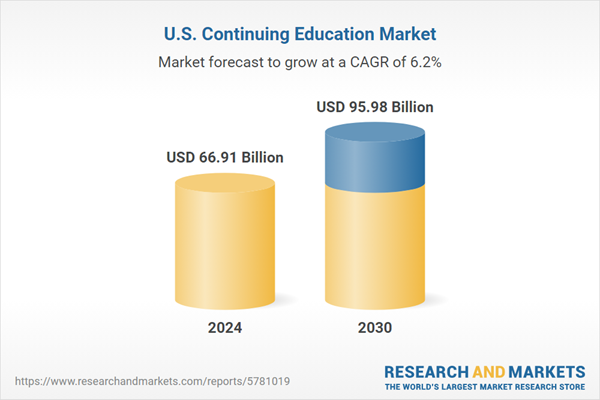Education
U.S. Continuing Education (CE) Market Report 2025-2030

Classroom learning currently holds over 41% of the market share, but e-learning is gaining ground. Notably, the accounting profession shows the fastest growth, with a 7.44% CAGR.
U.S. Continuing Education Market
Dublin, Aug. 22, 2025 (GLOBE NEWSWIRE) — The “U.S. Continuing Education Market Research Report 2025-2030” has been added to ResearchAndMarkets.com’s offering.
The U.S. Continuing Education Market was valued at USD 66.91 billion in 2024, and is projected to reach USD 95.98 billion by 2030, rising at a CAGR of 6.20%.
The continuing education market is shaped by the rapid expansion of online learning platforms, rising demand for skill-specific training, and growing collaboration between educational institutions and industry experts to deliver relevant content. Growth is further supported by government funding for workforce development, technological advancements that enhance interactivity, and stronger employer backing for continuous skill development. However, financial barriers for learners, inconsistent quality across programs, and challenges in measuring career impact remain key restraints.
KEY TAKEAWAYS
-
By Delivery Mode: The classroom learning segment accounted for the largest market share of over 41%.
-
By Profession: The accountants segment shows the highest growth of 7.44% during the forecast period.
-
By Providers: The educational institutions dominate and hold the largest market share in 2024.
-
Growth Factor: The U.S. continuing education market is set to grow due to rising demand for professional development and a surge in industry competitiveness.
U.S. CONTINUING EDUCATION MARKET SEGMENT INSIGHTS
INSIGHTS BY DELIVERY MODE
The U.S. continuing education market by delivery mode is segmented into classroom learning, e-learning, regularly schedules series, journals, and others. The classroom learning segment accounted for the largest market share of over 41%. Classroom learning remains a cornerstone of education, fostering a dynamic environment where students engage with peers and instructors in real-time. The physical presence of professionals fosters social interaction, empathy, and teamwork, crucial skills for navigating the world beyond academia.
The preference for classroom learning is declining compared with online learning. Although in the U.S., most CE learners prefer classroom learning over other methods because classroom learning increases potential skills and knowledge development under expert surveillance. In addition, face-to-face/in-person CE learning has experienced high penetration and is an accepted concept for a long back across the U.S. and the world. This significantly impacts the preference for delivery mode, with classroom learning being one of the methods experiencing high adoption by students compared with professionals.
INSIGHTS BY PROFESSION
The U.S. continuing education market by profession is categorized into healthcare workers, engineers, accountants, educators, architects, lawyers, and others. The accountants segment shows significant growth, with the fastest-growing CAGR of 7.44% during the forecast period. The field of accounting is built on a vast knowledge base that is continuously expanding, changing, and becoming more complex. To ensure that Certified Public Accountants (CPAs) provide the quality of advice and service that their clients depend on, CPE is vital. According to the National Association of State Boards of Accountancy, there were 671,855 actively licensed Certified Public Accountants (CPAs) in the United States in 2024. Continuing education is essential in this field to keep up with dynamic changes in tax law, financial regulations, and ethical practices. CE is also a requirement in most jurisdictions for license renewal and professional development.
The Corporate Finance Institute (CFI) is also a Continuing Professional Education (CPE) sponsor approved by the NASBA, which also offers continuing professional education for accounting professionals. CFI has designed a program providing 254.5 hours of CPE credits that focus mostly on Excel skills, financial analysis, financial modeling, valuation, and business strategy.
INSIGHTS BY PROVIDER
Based on the provider, the educational institutions dominate and hold the largest U.S. continuing education market share in 2024. Colleges, universities, and accredited architectural schools form the backbone of continuing education by offering certificate programs, workshops, and online modules tailored for licensed professionals. These institutions provide high academic credibility, often aligned with NCARB and AIA-approved standards. Educational institutions often partner with regulatory bodies like NCARB and state licensing boards to deliver CEU (Continuing Education Unit) programs. This alignment makes them a preferred choice among licensed architects needing to meet mandatory learning credits.
In response to the evolving needs of professionals, universities are increasingly offering hybrid and online delivery methods, allowing learners to balance ongoing work with professional growth. The integration of virtual design studios, AI-assisted design simulations, and sustainability labs has enhanced engagement and relevance.
Educational institutions remain a cornerstone of the U.S. CE market, especially in architecture. Their regulatory alignment, academic integrity, flexible delivery modes, and research-backed curriculum make them indispensable in meeting the ongoing professional development needs of both licensed and aspiring architects. As the number of license holders and candidates rises, these institutions are expected to witness sustained growth and relevance in this segment.
U.S. CONTINUING EDUCATION MARKET VENDOR LANDSCAPE
The U.S. continuing education market report consists of exclusive data on 28 vendors. The market is intensifying, with major platforms competing through AI integration, credential partnerships, and workforce specialization. LinkedIn Learning and Udemy are leading the race in AI education. LinkedIn leverages its Microsoft ecosystem for Azure and AI certifications, while Udemy has added over 1,000 new AI/ML courses. Skillsoft, through Codecademy’s AI coding labs, strengthens its technical training, creating a three-way competition among platforms targeting tech professionals.
Credentialing is another competitive front. Coursera holds an edge through academic collaborations like the University of London MBA pathway. LinkedIn and Udemy focus on professional certifications. LinkedIn is NASBA-accredited for finance professionals, and Udemy offers SHRM-recognized HR courses. Growing demand from corporate and government sectors has placed General Assembly and Skillsoft in direct competition. General Assembly’s U.S. Department of Labor apprenticeships appeal to the public sector, while Skillsoft’s compliance courses support corporate HR needs. Pearson is focusing on healthcare through its expanded medical communication certification programs.
Each platform uses a distinct model; LinkedIn integrates with Microsoft, Coursera bridges academics and careers, Udemy scales practitioner-led courses, General Assembly runs bootcamps, Skillsoft blends compliance and tech, and Pearson focuses on certification prep. As AI drives convergence, fragmentation across sectors makes strategic partnerships key to staying competitive.
Company Profiles
-
General Assembly
-
Skillsoft
-
Udemy
-
Coursera
-
LinkedIn Learning
-
Pearson
-
McKissock Learning
-
edX
-
Kaplan
-
Simplilearn
-
Pluralsight
-
Penn Foster
-
360training
-
Aceable
-
Advancement Courses
-
Antidote Education Company
-
AMA Ed Hub
-
AO North America
-
AcademicCME
-
AffinityCE
-
Becker Professional Education
-
Franklin Covey
-
Learning Tree International
-
HealthStream
-
Medscape
-
Stanford Medicine
-
Relias
-
TheCEShop.com
Education
US Education Department is all for using AI in classrooms: Key guidelines explained

Artificial intelligence (AI) has moved from being a futuristic concept to an active part of classrooms across the United States. From adaptive learning platforms to AI-powered lesson planning, schools are integrating technology to improve learning outcomes and ease teacher workloads. However, the challenge lies in adopting these tools without violating federal and state regulations.
Federal guidance: Innovation with safeguards
In July 2025, the US Department of Education issued guidance confirming that AI can be used in schools when aligned with federal laws. The framework focuses on three core principles—privacy, equity, and human oversight.AI tools must comply with the Family Educational Rights and Privacy Act (FERPA) to protect student data. Algorithms should be designed to prevent bias or discrimination under civil rights regulations. Human decision-making must remain central, ensuring that AI supports educators rather than replacing them.The Department also encouraged schools seeking federal grants to propose AI-driven projects, provided they meet these compliance standards.
State-level action: Rapid policy development
Since the federal guidance, more than half of US states have introduced their own AI frameworks for schools. Ohio now mandates that all districts adopt an AI-use policy by mid-2026, while Rhode Island has published detailed recommendations for responsible classroom integration.These local rules aim to ensure innovation while safeguarding student interests. However, the pace of policy development and the diversity of approaches have created a complex regulatory environment for schools.
Mixed practices at the local level
Despite progress, many districts still operate in a gray area. Policies differ widely between schools, and families often face uncertainty about what is permissible. Some institutions allow AI on personal devices while banning it on school-owned systems. In certain cases, schools have reverted to traditional measures, such as requiring handwritten essays in class to prevent AI-assisted work.This variation highlights the need for consistent guidelines and clear communication with students and parents.
AI as a classroom resource
Educators are increasingly using AI as a tool for efficiency and creativity. AI platforms assist in lesson planning, assessment design, and content generation, enabling teachers to save significant time on administrative work. These efficiencies allow more focus on interactive teaching and student engagement.AI-powered tutoring systems are also being introduced to provide personalised support, particularly for students who need extra academic help. States such as New Hampshire are experimenting with AI-driven tools to enhance math and reading instruction.
Responsible AI use: Best practices for schools
To remain compliant and maximise benefits, schools should adopt structured approaches to AI integration:
- Personalised Learning: Use adaptive platforms to tailor lessons while ensuring compliance with privacy regulations.
- Teacher Support: Allow educators to use AI for planning and administrative tasks with mandatory human review.
- Assessment Integrity: Shift from take-home essays to in-class writing or oral presentations to discourage misuse.
- Career Guidance: Deploy AI-driven counselling tools while retaining human oversight for final decisions.
Managing risks and ensuring compliance
AI adoption brings challenges that schools must address proactively:
- Bias Prevention: Regular audits are necessary to eliminate algorithmic bias.
- Privacy Protection: All tools should meet FERPA standards and undergo security checks.
- Avoiding Over-Reliance: AI should support, not replace, teacher judgment in academic and disciplinary matters.
Comprehensive district-level policies, continuous teacher training, and stakeholder engagement are essential for responsible use.
The road ahead
The Department of Education is collecting public feedback on AI-related policies and exploring ways to integrate AI into its own operations. States will continue rolling out new requirements in the coming months, making 2025 a critical year for AI in education.The future of AI in classrooms depends on a balanced approach—leveraging its potential to improve learning while upholding legal and ethical standards. Schools that integrate AI responsibly will not only enhance student outcomes but also prepare learners for a technology-driven world.
Education
State Superintendent Thurmond Convenes Statewide AI in Education Workgroup for Public Schools – Van Nuys News Press

SACRAMENTO—State Superintendent of Public Instruction Tony Thurmond hosted the first meeting today of the Public Schools: Artificial Intelligence (AI) Workgroup at the California Department of Education (CDE) Headquarters in Sacramento. Established after last year’s passage of Senate Bill 1288, a bill authored by Senator Josh Becker (13th District) and sponsored by Superintendent Thurmond, the workgroup marks California as one of the first states in the nation to establish a legislatively mandated statewide effort focused on AI in K–12 education.
“There is an urgent need for clear direction on AI use in schools to ensure technology enhances, rather than replaces, the vital role of educators,” said Superintendent Thurmond. “Workgroup members are representatives from various organizations, including technology leaders. The majority are educators, and this workgroup also includes students. We want to ensure that those who will be affected by this guidance and policy have a voice in creating it.”
The workgroup is a model of Superintendent Thurmond’s efforts to develop strong public–private partnerships that power innovation in public education. It will develop the statewide guidance and a model policy to ensure AI benefits students and educators while safeguarding privacy, data security, and academic integrity. The group includes teachers, students, administrators, classified staff, higher education leaders, and industry experts. At least half of the members are current classroom teachers, elevating educator expertise as the foundation for decision-making.
The launch of the Public Schools: Artificial Intelligence Workgroup directly advances Superintendent Thurmond’s priorities, which include
- Transforming Education with Innovation: equipping schools with equitable, forward-looking approaches to technology;
- Equity and Access for All Students: ensuring AI tools do not exacerbate inequities but instead expand opportunities for every student;
- Whole Child Support: safeguarding against bias, misuse, and misinformation in AI systems while protecting student well-being;
- Elevating Educator Voice: centering teachers in decision-making about AI in classrooms; and
- Transparency and Public Engagement: committing to openness through public meetings and shared resources.
Today was the initial meeting of the Public Schools: Artificial Intelligence Workgroup. The second meeting will take place in October, followed by a third meeting in February.
The CDE has released initial guidance for schools and educators regarding the use of AI, which will be enhanced by the work of this group. The initial guidance can be found on the CDE Learning With AI, Learning About AI web page.
Education
The Guardian view on GCSE resits: admitting the problem is just the first step | Editorial

For years, rigid rules and a shocking failure rate in compulsory GCSE retakes have been one of the exam system’s dirty secrets. At last this dire situation is getting some of the attention it deserves. This year, nearly a quarter of all maths and English language entries in England, Wales and Northern Ireland were for students aged 17 or older on a repeat attempt – with just one in six of those retaking maths managing to pass.
By calling this a crisis, Jill Duffy, who heads the OCR exam board, has thrown a spotlight on the problem. But admitting that there is an issue with resits, as officials are now doing, is only the first step. There are differing views about what ought to happen next.
Reforming GCSEs is outside the scope of the review being led by Prof Becky Francis. But a proposal to ditch compulsory resits is on the table. The Sixth Form Colleges Association wants a second attempt to be followed – for those who fail – by a modular alternative. This would mean students not being forced to endlessly repeat the parts of the courses they have mastered, and focusing instead on the gaps.
Nick Gibb, the former Conservative schools minister, has predictably set his face against change and demanded that all schools follow the example of the best. But while big variations in results should be drilled into, and successes learned from, this is not an adequate response. Many subject experts believe that the qualifications are poorly designed if their purpose is to serve as a universal gateway to the world of work. Rather than sticking to vital competencies (such as numeracy, statistics and reading comprehension), the current versions include calculus and geometry (in maths) and quasi-literary analysis (in English language).
It is a great shame that these issues were not grasped more effectively by Labour in opposition. Changes to the curriculum and exam system are a painstaking process. Prof Francis’s review is the best chance of breaking a destructive cycle. But the Department for Education’s recent record of engagement with the further education sector – where most resits are taken – is not good. There is no secondary English specialist on the review, and teacher shortages and challenges around provision for special educational needs and disabilities remain concerning.
Resits must also be seen in the context of a wider debate around the future of post-16 education, including the pledge by ministers to abolish courses that they see as unwelcome competition to T-levels. As with resits, critics of this policy are most worried about less academically able pupils with lower test scores. Even the government’s own figures show a gap, with tens of thousands of students on the threatened courses, including some BTecs, potentially unsuited to newer alternatives.
With a skills white paper due in the autumn, it is not too late to tackle unanswered questions. A better balance between ambition and pragmatism can surely be found. Plenty of jobs in the UK do not require calculus or textual analysis. T-levels were meant to boost less academic, more practical teenagers. This year’s resit figures are a worrying addition to existing evidence that these are the pupils for whom the system works least well. Ministers must be absolutely confident that any changes they introduce make things better, and not worse.
-
Tools & Platforms3 weeks ago
Building Trust in Military AI Starts with Opening the Black Box – War on the Rocks
-

 Business2 days ago
Business2 days agoThe Guardian view on Trump and the Fed: independence is no substitute for accountability | Editorial
-

 Ethics & Policy1 month ago
Ethics & Policy1 month agoSDAIA Supports Saudi Arabia’s Leadership in Shaping Global AI Ethics, Policy, and Research – وكالة الأنباء السعودية
-

 Events & Conferences3 months ago
Events & Conferences3 months agoJourney to 1000 models: Scaling Instagram’s recommendation system
-

 Jobs & Careers2 months ago
Jobs & Careers2 months agoMumbai-based Perplexity Alternative Has 60k+ Users Without Funding
-

 Funding & Business2 months ago
Funding & Business2 months agoKayak and Expedia race to build AI travel agents that turn social posts into itineraries
-

 Education2 months ago
Education2 months agoVEX Robotics launches AI-powered classroom robotics system
-

 Podcasts & Talks2 months ago
Podcasts & Talks2 months agoHappy 4th of July! 🎆 Made with Veo 3 in Gemini
-

 Podcasts & Talks2 months ago
Podcasts & Talks2 months agoOpenAI 🤝 @teamganassi
-

 Mergers & Acquisitions2 months ago
Mergers & Acquisitions2 months agoDonald Trump suggests US government review subsidies to Elon Musk’s companies



















